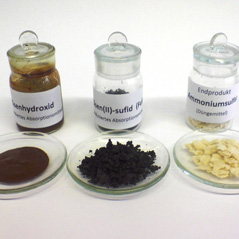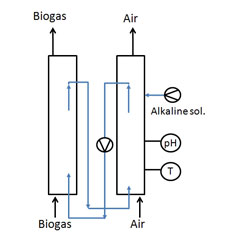H2S-removal from biogas
The MicroPro GmbH has developed an efficient technique for the H2S-removal from landfill- and biogases.
The patented technique is based on the gas scrubber system
- The hydrosulphide ( H2S) containing biogas is fed through a scrubber column, where H2S is absorbed by an iron-containing solution. This scrubbing process is highly efficient and reliable. Remaining H2S concentration in the cleaned biogas is below 50 ppm. There is no adverse alteration of biogas composition, since no additional gases (air, oxygen) are carried into this column.
- The washing solution circulates in a second column were the solution is regenerated by aerobic microorganisms. The absorbed sulphide is oxidized biologically to sulphate. The pH is controlled by addition of ammonia. The ammonia and sulphate enriched washing solution can be combined with the digestate from the biogas fermenter and used as fertilizer.
Technological advantages:
- Highly efficient, as a reduction of H2S content by far more than 90 %, independent of initial concentration (100 – 5.000 ppm)
- Clean technology, as the technological design guaranties no air or oxygen enters the biogas system
- Affordable by combination of chemical scrubbing technology with biological oxidation
- flexible, as highly variable sulphur contents are chemically buffered
More information
The anaerobic degradation of organic materials results in the conversion of carbon-, nitrogen-, and sulphur-containing organic compounds to the gaseous compounds methane, carbon dioxide, ammonia, molecular nitrogen and hydrosulphide. Methane represents the main compound of this gas mixture with 50 to 75% (v/v). This so-called biogas is used for example as fuel for block heat and power plants. The most problematic compound of this gas mixture is hydrosulphide, which can make up to 5000 ppm of the biogas. This compound is highly toxic and has also a strong corrosive property. Therefore this compound must be effectively eliminated before the biogas is used for production of electric or thermic energy or the use in conventional gas pipeline network.
The concept is based on chemical absorption of H2S by means of an iron-containing washing solution with subsequent biological regeneration. The washing solution contains minerals and is simultaneously used as nutrient broth for selected microorganisms.
The system consists of two separate reaction columns and a circulating washing solution. Both reactions, the chemical absorption of H2S and biological regeneration of iron ions run in parallel but separately in the two columns. A mixture of oxygen-free biogas and air is therefore completely excluded.
One column is used as biogas scrubber, where the sorption of H2S occurs. The resulting iron sulphide (FeS) circulates together with the solution into the second column for regeneration, which is filled up with growth bodies and aerated. Here aerobic microorganisms oxidize bound sulphur and produce sulphuric acid.
Final products of this oxidation process are completely soluble and can easily be discharged into the digestate for further use.
Beside hydrosulphide ( H2S) also ammonia is removed from biogas by this process.


